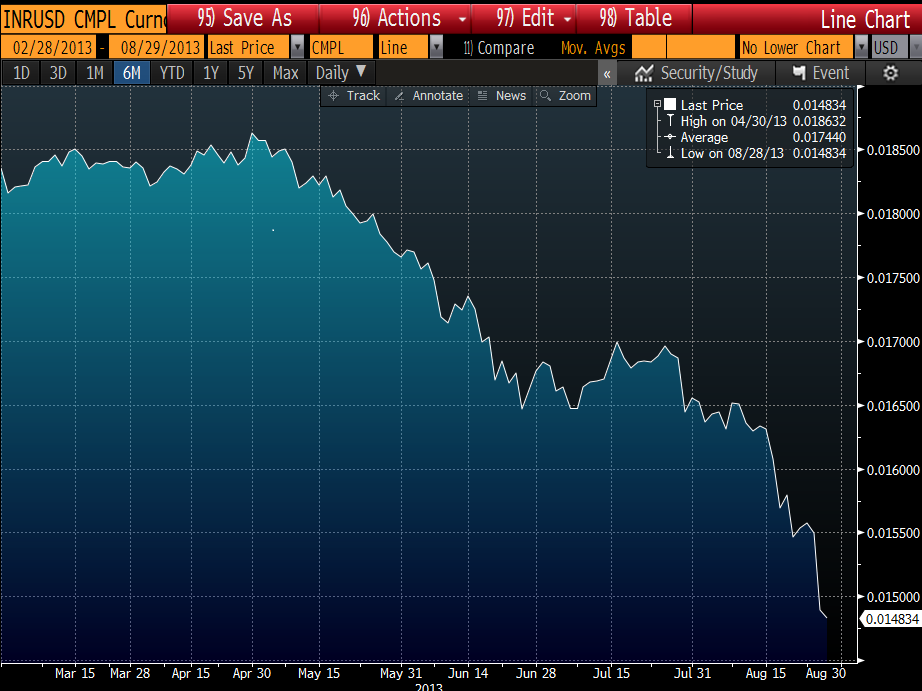As the Indian Rupee hit a fresh all-time low today against the US dollar, we wondered about the factors that could have caused this recent massive revaluation.
There are several powerful factors at work:
- The U.S. Federal Reserve. During the last few years of the U.S. Fed’s aggressive stimulus program, investors had access to cheap capital, which many took abroad in search of the higher returns to be found in higher risk emerging markets. Recently, as the Fed has begun discussing withdrawing its stimulus by reducing its heavy treasury bond purchases, investors have turned risk averse, seeking safer assets and the prospect of higher yields in the US. Among the emerging economies that have suffered from this flight-to-quality, India has been hit especially hard. Consider this ugly graph of the Indian Rupee, which has declined by over 20% over the past 4 months:
Aye Caramba! As you can see from the graph, the selloff has intensified over the past few weeks, as panic market psychology has taken hold. But in addition to the Fed’s tapering talk, there several underlying structural reasons that have also contributed to the decline.
Many market commentators have attributed the Rupee’s weakness to its large current account deficit, as imports have exceeded exports. This is a generally bad thing, since in order to fund its current account, India requires foreign capital. Today foreign capital is fleeing the country, and so India must draw down on its foreign currency reserves or issue sovereign bonds to fund the gap. Investors don’t like either of these possibilities.
Normally, the current account deficit would be improved by a falling rupee, as a cheaper currency would boost exports. But because of high inflation in the Indian economy – the Indian CPI jumped 9.6 percent in July — exports are not getting cheaper in real terms. Meanwhile growth in the broader Indian economy is slowing to the 5% range, sluggish by recent historical standards, thus raising the possibility of negative real growth. Investors don’t like this possibility much either.
- India’s worsening public debt position. Cumulative government borrowings currently represent approximately 60% of India’s GDP, while India’s fiscal deficit (the difference between tax revenues and public expenditures) is running at 5-6% of GDP. Another complicating factor is that 44 percent of India’s external debt matures in the current fiscal year, which ends in March 2014. As one person in our firm put it, “How the hell did that happen?!” One wonders whether India will be the first BRIC to lose investment grade status.
- India’s populist subsidy policies: Voter friendly, but also currently make up 2.4% of GDP, or approximately half of the fiscal deficit. These are popular policies that are difficult to undo. Consider that the government provides subsidized grain to 70% of its 1.2 billion population. India also provides fuel subsidies, which are especially important as it imports 75% of its oil. With a falling rupee, these imports are getting more expensive. The recent escalation of tensions in Syria may also be weighing on the rupee, as military action by the US against Syria would raise oil prices, and send a supply shock through the Indian economy, which could further increase pressure on Indian politicians to subsidize fuel.
With an election scheduled for mid-2014, it seems unlikely that the current elected political class would do anything, such as remove these popular subsidies, which would anger large segments of the population. But then, given the faltering economy, inflation and the plunging rupee, the Indian people may have to face up to some unpleasant realities.
Anyone up for some Spicy Tandoori Chicken?
About the Author: David Foulke
—
Important Disclosures
For informational and educational purposes only and should not be construed as specific investment, accounting, legal, or tax advice. Certain information is deemed to be reliable, but its accuracy and completeness cannot be guaranteed. Third party information may become outdated or otherwise superseded without notice. Neither the Securities and Exchange Commission (SEC) nor any other federal or state agency has approved, determined the accuracy, or confirmed the adequacy of this article.
The views and opinions expressed herein are those of the author and do not necessarily reflect the views of Alpha Architect, its affiliates or its employees. Our full disclosures are available here. Definitions of common statistics used in our analysis are available here (towards the bottom).
Join thousands of other readers and subscribe to our blog.


